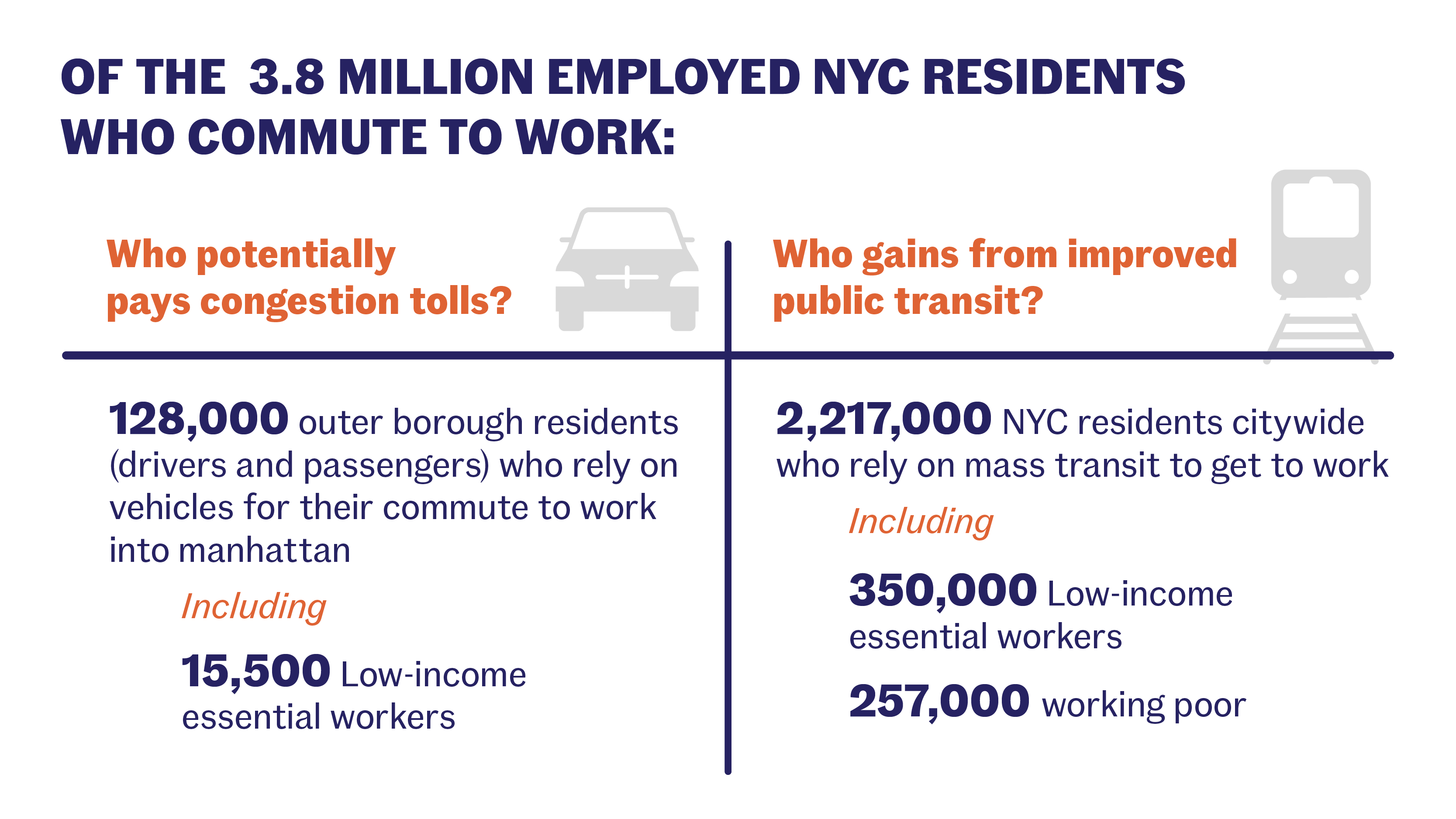What Does Congestion Pricing Mean for Outer-Borough New Yorkers in Poverty?
An Updated CSS Analysis
Irene LewDebipriya ChatterjeeEmerita Torres
Introduction
New York City’s chronic transportation woes hit a tipping point in 2017. The subways were in deep crisis, plagued by overcrowding, delays, and breakdowns. At the same time, above ground, the streets were increasingly clogged by the boom in ride-hailing apps like Uber and Lyft. Following decades of on-and-off-again debate, and nine years after Mayor Michael Bloomberg’s congestion pricing proposal died in Albany, it was once again revived as a possible solution in August 2017, when Gov. Andrew Cuomo announced congestion pricing as “an idea whose time has come” and convened a state task force to develop a congestion pricing plan.
With congestion pricing drawing serious interest, the Community Service Society of New York (CSS) decided to examine its prospective impacts on the city’s working residents in poverty. Our October 2017 analysis was widely cited by advocates to debunk the idea that a congestion fee would be burdensome for large numbers of low-income New Yorkers.
In April 2019, New York state lawmakers enacted legislation authorizing the MTA to levy a charge on motor vehicles entering Manhattan south of 61st Street, opening the door to the first comprehensive congestion pricing program in the United States. The plan would provide a dedicated revenue stream of $1 billion a year to fund urgently needed improvements to the city’s aging public transit system. The plan was initially scheduled to take effect in early 2021, but implementation stalled when the Trump Administration failed to provide guidance on the required environmental review. Two years later in 2021 and after receiving the necessary guidance from the Biden administration, the MTA kicked off the federally mandated environmental study with an initial round of public hearings in September. But the 16-month review process means that the start date for congestion pricing is being pushed into 2023, two years behind the original schedule.
Congestion pricing is sorely needed now to alleviate worsening traffic: even as subway and bus ridership remains 40 percent below pre-pandemic levels, bridge and tunnel traffic volumes across the city are now nearly back to 2019 levels. On top of this, new vehicle registrations in 2021 are up 34 percent over the previous year. More cars on the road inevitably leads to more gridlock; New York-based economist Charles Komanoff estimates that if just 1 in 10 pre-pandemic public-transportation travelers switched to cars, there would be a 45 percent increase in vehicle volume in Manhattan’s central business district. Worsening traffic has also made the city’s streets deadlier for pedestrians and cyclists, with traffic fatalities surging to their highest level in nearly a decade.[1]
As the MTA reviews the environmental benefits of congestion pricing, including its prospective effects on low-income communities and people of color, we have updated our 2017 analysis[2] using more current 2015-2019 American Community Survey Five-Year data available from the Census Bureau.
Key Findings
- Among all income strata of outer-borough residents (those living in Brooklyn, the Bronx, Queens and Staten Island), no more than four percent would regularly pay a congestion fee.
- Of the city’s outer-borough working residents in poverty, only two percent — around 5,000 residents — will be asked to pay a congestion fee as part of their daily commute.
- Outer-borough households in poverty are nearly three times more likely as high-income outer-borough households to lack a motor vehicle.
- A majority of low-income essential workers living in the outer boroughs depend on public transportation to reach their jobs; no more than three percent will be asked to pay a congestion fee as part of their daily commute.
- For every working New Yorker in poverty who will regularly face a congestion charge, 50 workers will benefit through the mandated investment of congestion revenues in transit upgrades.
Consistent with our 2017 analysis, only four percent[3] of outer-borough residents would regularly pay the congestion charge; the majority of outer-borough residents depend on public transportation to get to work and stand to benefit from congestion pricing.
The vast majority (82 percent) of outer-borough residents working in Manhattan are moderate to higher income, whereas only a small minority are low income (18 percent). Overall, we found that only four percent of the city’s workforce living in the outer boroughs (around 128,000 people) commute to jobs in Manhattan by vehicle (car, truck, van, motorcycle, or taxi) and could be subject regularly to a congestion fee. In contrast, public transportation is the way that most outer-borough residents get to work: the share commuting by public transit (57 percent) is six times higher than the share relying on vehicles for their daily commute to Manhattan (See Figure 1).
Figure 1: Vast majority of outer-borough residents would not be affected by congestion pricing
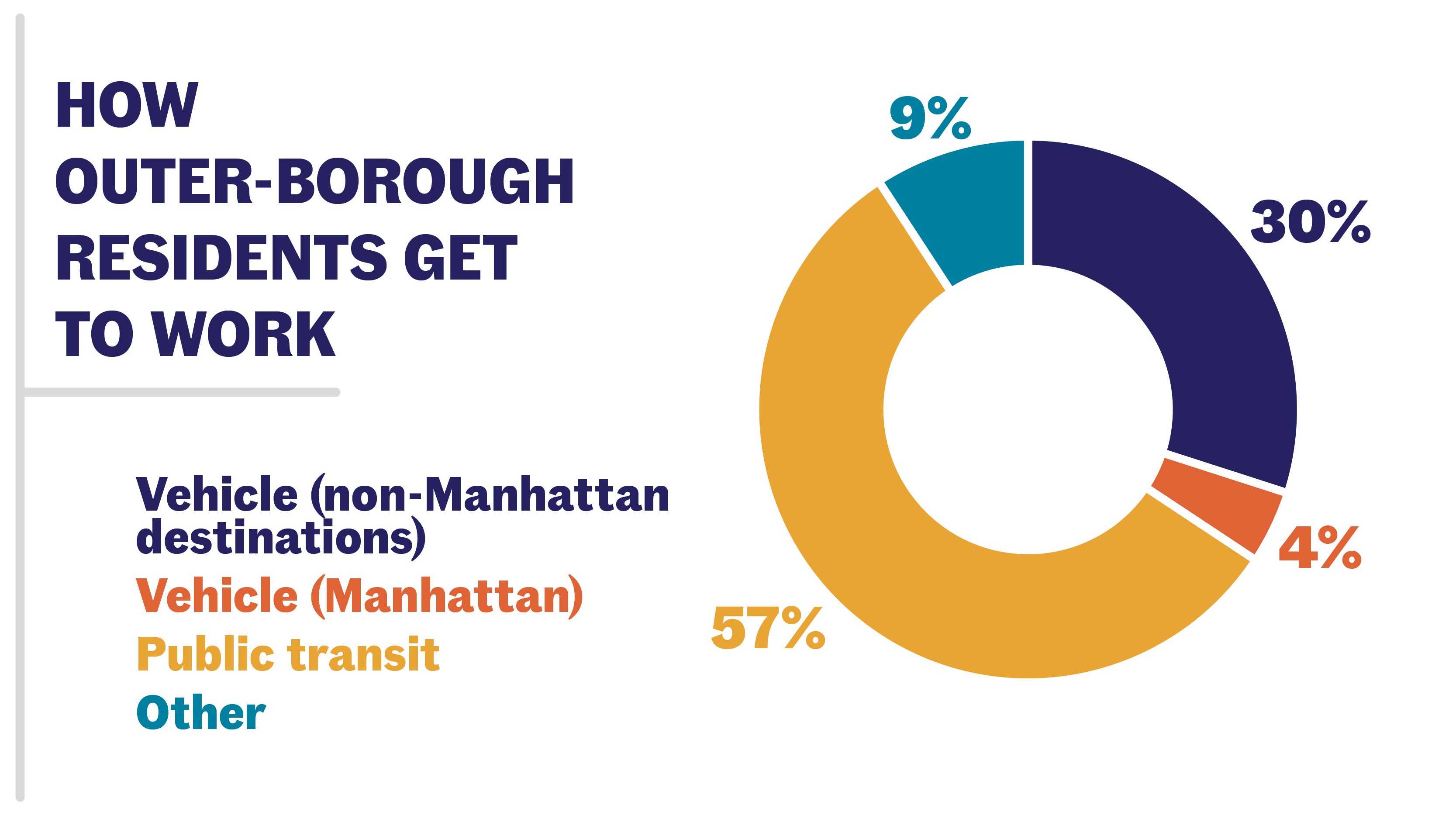
Source: CSS analysis of 2015-2019 American Community Survey Public Use Microdata Sample
Only two percent of the city’s outer-borough working residents in poverty (around 5,000 residents) would be asked to pay a congestion fee as part of their daily commute.
In line with our 2017 analysis, we found that a very small fraction—two percent—of outer-borough residents with incomes below the federal poverty level[4] commute into Manhattan by vehicle and could be charged under a congestion pricing program (See Figure 2). On the other hand, 61 percent of these residents in poverty rely on public transportation to get to their jobs, and therefore stand to benefit from a congestion pricing plan that raises money for improved transit. (The remainder commute by vehicle to other destinations outside of Manhattan, or walk or bike to their jobs.)
Figure 2: Among outer-borough residents in poverty, a very small fraction would be affected by congestion pricing
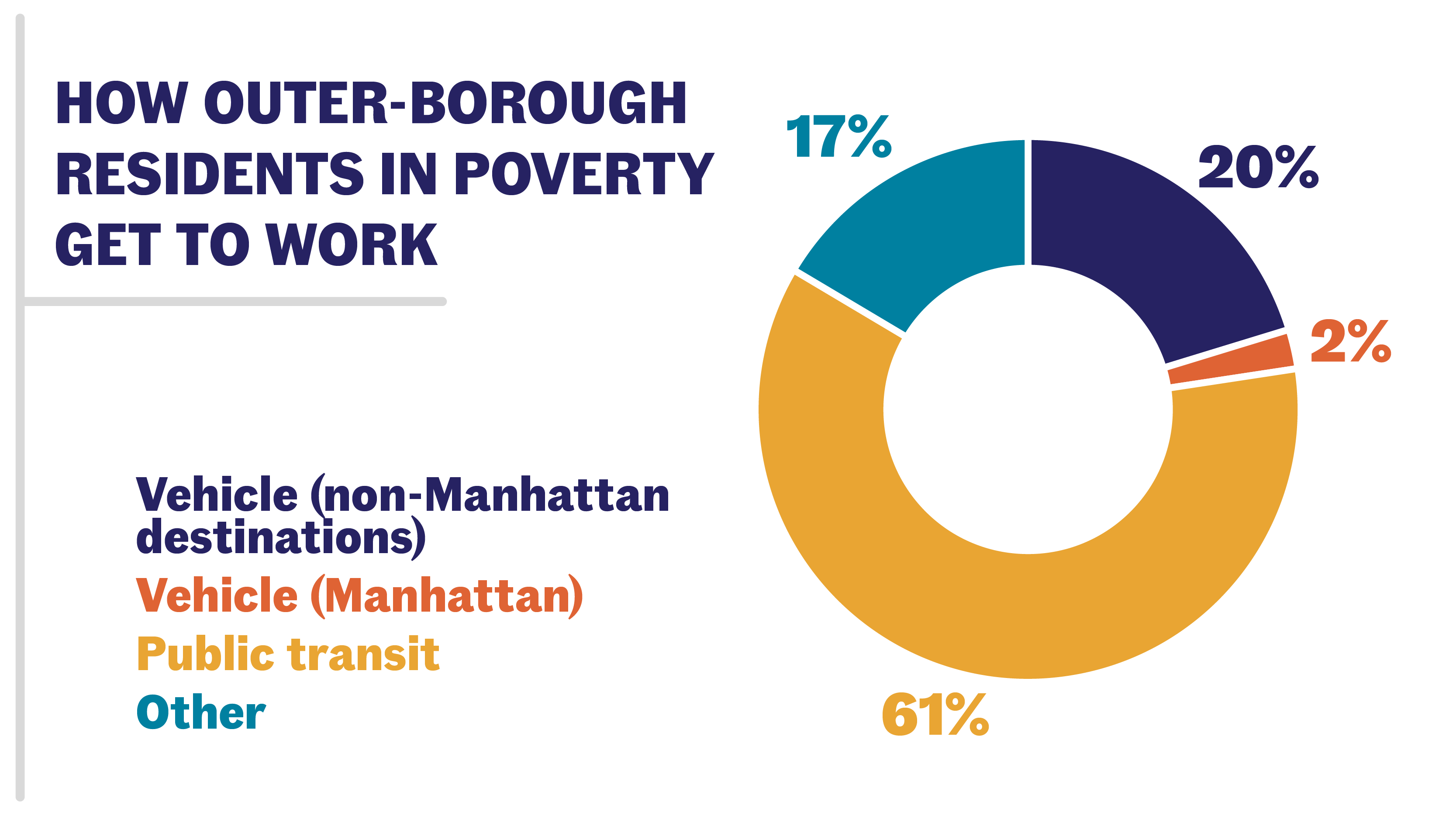
Source: CSS analysis of 2015-2019 American Community Survey Public Use Microdata Sample
Poor outer-borough households are nearly three times more likely as high-income outer-borough households to lack a motor vehicle.
Census data shows that most New Yorkers living in the outer boroughs who own cars are well-off: outer-borough households with cars have a median income of $94,000, more than twice as high as that of car-free households ($42,000). In fact, as Figure 3 shows, among outer-borough households, residents in poverty are nearly three times more likely as high-income residents to lack a vehicle: 68 percent of outer-borough households in poverty lack a motor vehicle vs. just 24 percent of high-income outer-borough households. Car ownership is out of reach for most low-income families because the costs present a financial burden.[5] Even though car ownership in New York City surged during the pandemic, it is likely that high-income households comprised the vast majority of new car registrations.
Figure 3: Most outer-borough residents in poverty do not own or use a car for commuting purposes
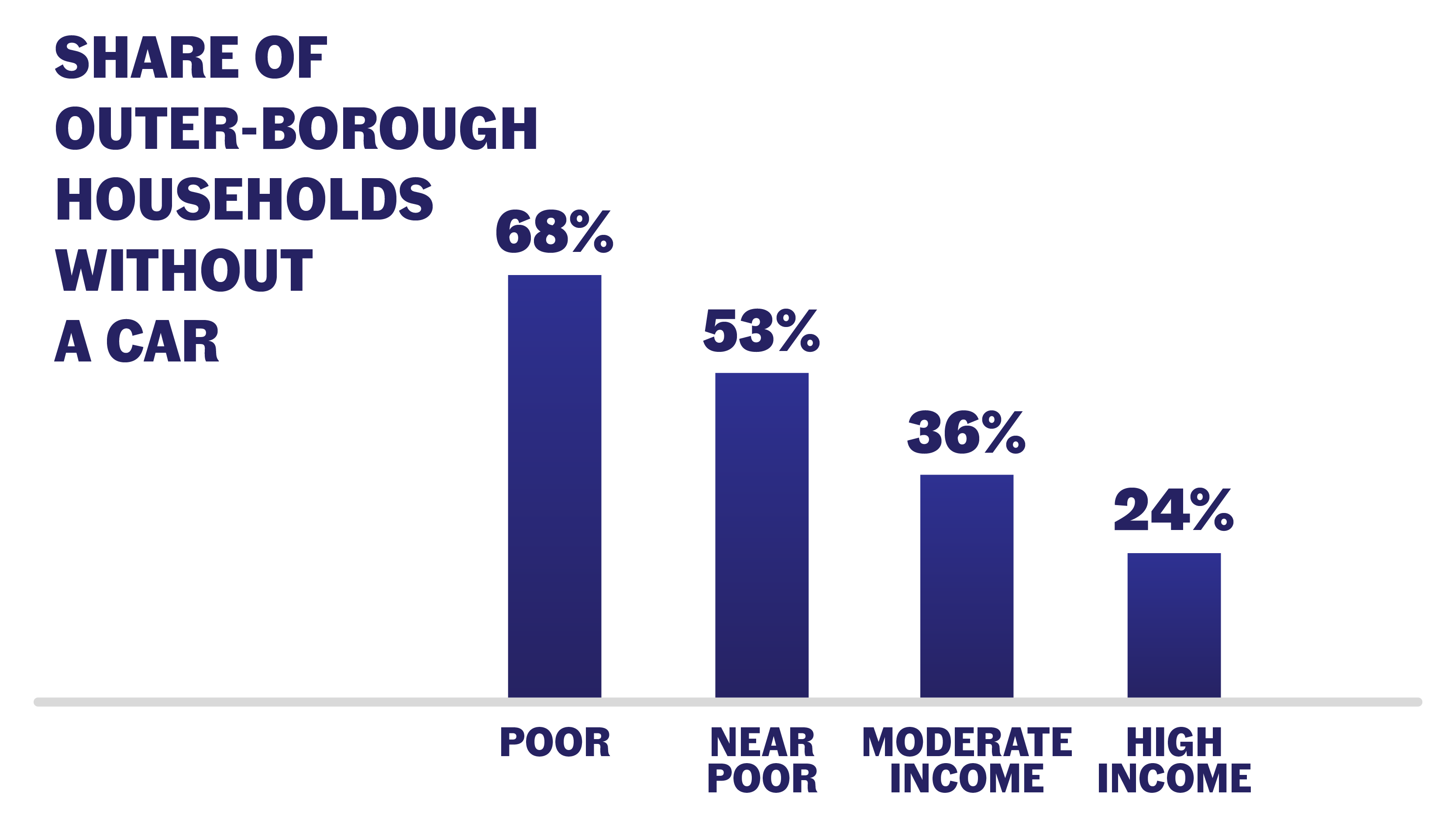
Source: CSS analysis of 2015-2019 American Community Survey Public Use Microdata Sample
Most low-income essential workers living in the outer boroughs depend on public transit and just three percent might pay a congestion fee.
Most essential workers,[6] such as those who restock our grocery shelves and staff our hospitals, depend on public transit. The majority of these essential workers are in the healthcare, retail, food, and other service industries. Of an estimated 1.9 million essential workers who live in the outer boroughs, 34 percent (around 650,000) commute to jobs in Manhattan. The large majority (86 percent) of this essential workforce (around 557,000) uses public transportation for their daily commutes from the outer boroughs to Manhattan. At the height of the pandemic in spring 2020, the mandatory shutdown led to a 90 percent plunge in subway ridership, as most workers stayed home or transitioned to working remotely. But essential workers, many living in lower-income neighborhoods in Queens, Brooklyn, and the Bronx, continued to ride the subways and buses to their jobs.
There are an estimated 481,000 low-income essential workers who commute to work from the outer boroughs. Figure 4 shows that only 3 percent (15,500) of them commute to Manhattan by vehicle and could potentially be charged a congestion fee as part of their daily commute, while 62 percent use public transit to get to their jobs.
Figure 4: Vast majority of low-income essential workers residing in outer-boroughs would not be affected by congestion pricing
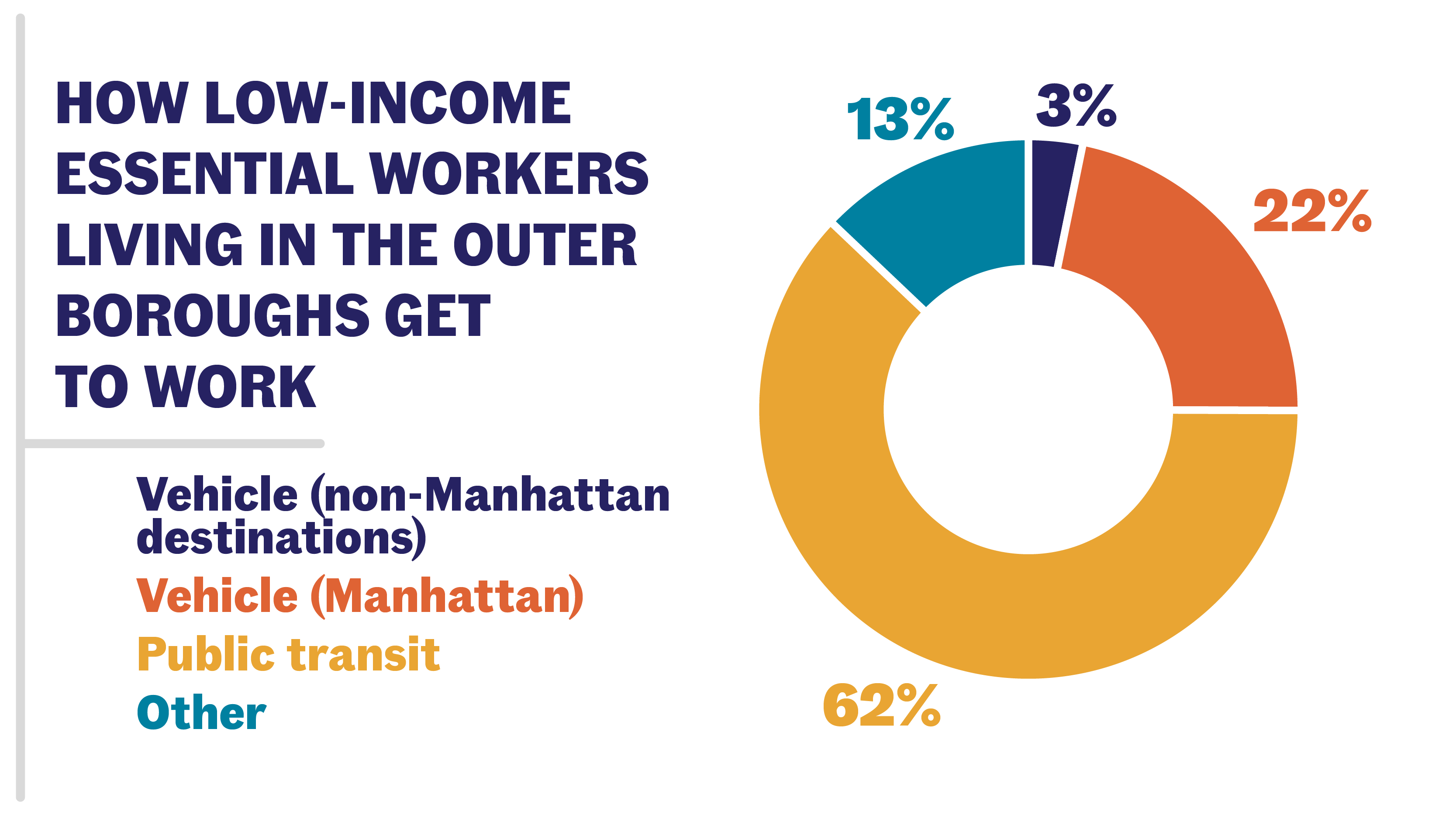
Source: CSS analysis of 2015-2019 American Community Survey Public Use Microdata Sample
Conclusion
Our analysis confirms that, with relatively few exceptions, congestion pricing will not be a regressive surcharge on New Yorkers in poverty. As shown in Figure 5 below, 257,000 working poor New Yorkers would benefit from a congestion pricing plan that funds transit upgrades, compared to just 5,000 New Yorkers who would regularly pay a congestion fee. In other words, working residents in poverty will benefit by a margin of more than 50 to 1 from congestion pricing that funds transit upgrades (See Figure 5).
Furthermore, the city’s low-income essential workforce also stands to reap enormous benefits from a more reliable transit system. Compared to only 15,500 low-income essential workers who could pay a congestion fee, 350,000 low-income essential workers would benefit from congestion pricing—a margin of 23 to 1.
Figure 5: Summarizing the effects of congestion pricing on working NYC residents
Not only did the torrential flooding and damage to the subways caused by Hurricane Ida highlight the adverse impacts of climate change on the city’s most vulnerable residents, but it also underscored the importance of a robust new revenue source for strengthening the city’s public transit system against future storms. Congestion pricing is poised to generate revenue to enable the MTA to invest $15 billion in transit upgrades—a vital infusion in funds at a time that the MTA is facing perhaps its most dire budget crisis in history. While the New York City region is poised to receive more than $10 billion from the historic bipartisan infrastructure bill recently signed into law by President Biden, that is almost certainly a one-shot infusion that does not address the MTA’s long-term budget deficits.
Recommendation
The MTA must expedite the review process for enacting congestion pricing and refrain from offering additional carveouts and exemptions.
Currently, the only exemptions from congestion pricing are emergency vehicles and those carrying people with disabilities, while residents living within the congestion pricing zone and those earning less than $60,000 a year would receive tax credits.[7] The MTA has noted that rates charged could range from $9 to $23 for passenger vehicles using EZ-Pass but that base rate would likely be higher if more exemptions are granted.[8]
As people return to jobs in Manhattan’s central business district, there will be increased pressure on crossings and city streets, as well as increased risk of traffic fatalities. New York recently overtook Los Angeles to rank as the most congested city in the country. Congestion pricing will not only alleviate traffic for auto drivers, bus riders, and truckers traveling to Manhattan’s central business district, it will also reduce noise and air pollution and improve health outcomes. London, Stockholm, Milan, and Singapore find that congestion pricing is reducing traffic, improving public transit, and reducing carbon emissions. Most importantly, enacting congestion pricing is a key part of an equitable economic recovery. Public transit is how most low-income New Yorkers and essential workers get around the city, and this workforce deserves a reliable and upgraded public transportation system worthy of the sacrifices they have made to keep New York City running during the ongoing COVID-19 pandemic.
Notes
1. Hu, Winnie. The New York Times. “De Blasio Vowed to Make City Streets Safer. They’ve Turned More Deadly.” September 30, 2021.
2. CSS based its 2017 analysis on the 2011-15 American Community Survey (ACS) five-year estimates.
3. Limitations in publicly available data did not allow us to exclude drivers and passengers traveling to jobs in Manhattan outside the Central Business District or who already take tolled tunnels and would not pay additional congestion fees. Both these factors would make our four percent figure an overestimate. We were also unable to identify the number of workers commuting by vehicle through Manhattan’s CBD to reach another destination in another borough or outside of New York City. Accounting for these drivers would underestimate outer-borough working residents who could pay congestion tolls.
4. In 2020, the federal poverty threshold for a two-adult, two-child family is $26,246. See here.
5. One estimate found that that car ownership can account for 29 percent of household budgets for low-income working families in the U.S. on average. See here.
6. Based on the industries listed in this NYS executive order.
7. Trips that use the FDR Drive and West Side Highway to bypass the charging zone also won’t be charged. See here.
8. Gold, Michael. The New York Times. “Congestion Pricing Is Coming to New York. Everyone Has an Opinion.” October 21, 2021. Analysis by Komanoff suggests that a toll plan charging $13 during peak hours and $4 off-peak would enable the plan to satisfy its mandate to net $1 billion a year in revenue, suggesting that tolls as high as $23 are unlikely.
